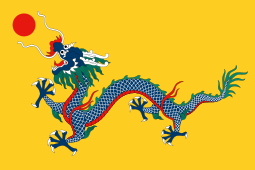 | |
| Yellow Dragon Flag (黃龍旗) | |
| Use | National flag and ensign |
|---|---|
| Proportion | 2:3[1] |
| Adopted | 1889 |
| Relinquished | February 12, 1912 |
| Design | Blue dragon on plain yellow, with a red pearl at the upper left corner. |
| Earlier version of Yellow Dragon Flag | |
 | |
| Use | State and war flag, state and naval ensign |
| Proportion | 56:87 |
| Adopted | 1862 |
 | |
| Use | Imperial Standard |
| Proportion | 56:87 |
| Adopted | 1862 |
| Design | The Imperial Standard for the Emperor of China |
The flag of the Qing dynasty was an emblem adopted in the late 19th century (1889) featuring the Azure Dragon on a plain yellow field with the red flaming pearl in the upper left corner. It became the first national flag of China and is usually referred to as the "Yellow Dragon Flag" (traditional Chinese: 黃龍旗; simplified Chinese: 黄龙旗; pinyin: huánglóngqí).
Ruling China from 1644 until the overthrow of the monarchy during the Xinhai Revolution, the Qing dynasty was the last imperial dynasty in Chinese history. Between 1862 and 1912, the dynasty represented itself with the dragon flag.
On January 10, 1912, the Yellow Dragon Flag was replaced by the Five-Colored Flag,[2] and on February 12 Emperor Pu Yi abdicated, ending the rule of the Qing Dynasty.
- ^ "Dimension of first yellow dragon flag from Wuhan Custom Archive". Archived from the original on 2015-09-30. Retrieved 2016-06-30.
- ^ "The Flag of China: The Story of Magic, Charm, and Legends". 2024-03-14. Retrieved 2024-09-24.